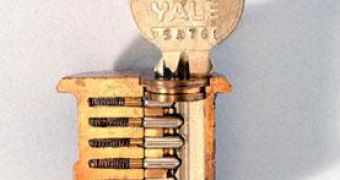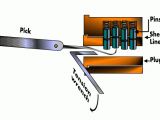You have seen it a thousand times in movies or heard about it in the news. But is it really possible to pick a lock and if so, is it that easy? Well, theoretically whatever is locked will eventually be unlocked one way or the other. Though there are multiple types of lock designs, over the years one seems to have succeeded in being the most popular - the cylinder lock - as it offers relatively high security and is inexpensive at the same time.
The basic design of the cylinder lock involves a deadbolt lock spring loaded mechanism placed between a tumbler cylinder that turns inside a massive metal jacket. Both have a series of holes that line up, in which the spring loaded pins are dropped. Notice in the picture how every hole houses a spring and two sets of pins? The upper ones have all the same length, while the lower pins differ in size.
When the key is not inside the lock, the upper pins penetrate the tumbler blocking the shear line thus preventing it to turn and unlock the door. When the correct key of the lock is inserted, the lower pins inside the tumbler follow the shape of the key, moving up and down. When reaching the final position, the upper pins inside the lock move over the shear line between the tumbler and the surrounding metal jacket, enabling the tumbler to rotate freely inside it.
Although this puzzle design is relatively simple, it is extremely effective since the pins are hidden inside the lock, making it fairly difficult to find the correct key for most people. However, with a lot of practice picking a lock is relatively easy.
All you need is a pick that represents a thin piece of metal used to push the pins up and a tension wrench. The process involves inserting the pick inside the tumbler to push the pins up. At the same time, apply tension against the tumbler in the rotation direction. Keep the tumbler under pressure and slowly pull the pick out of the lock while at the same time exerting pressure on the pins. Due to the fact that the tumbler is tensioned and the mechanism isn't perfectly fabricated, as you release the pressure on the pins the superior pins will be deactivate on the edge of the shear line, thus unlocking the lock.
Similar techniques involve a so-called raking process in which the rake bounces all the pins at the same time while applying tension on the tumbler. During this process the upper pins will also fall on the edge of the tumbler thus unlocking it.

 14 DAY TRIAL //
14 DAY TRIAL // 
